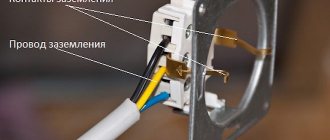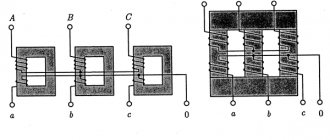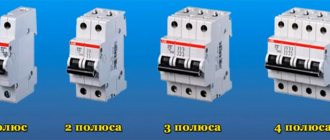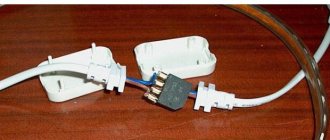The question of whether to install an RCD on a lighting circuit has recently remained relevant. Meanwhile, there are no strict regulations regarding the installation of RCDs on lighting lines. Let's see what an RCD can provide in this case, and how things will be without it. After which each reader will be able to make a conclusion for himself whether to install an RCD for lighting or not.
RCD for lighting
First, let's look at the regulatory documents. Let's look at the PUE:
In group networks feeding plug sockets, an RCD with a rated operating current of no more than 30 mA should be used. It is allowed to connect several group lines to one RCD through separate circuit breakers. Installation of RCDs in lines supplying stationary equipment and lamps, as well as in general lighting networks, is usually not required.
According to this paragraph, the installation of RCDs in lighting circuits can be neglected. Whoever does not install an RCD here is, in principle, not violating anything. But personally, we always recommend installing an RCD for lighting. Our opinion is that the preposition “not” before the word “required” should be removed from this paragraph of the PUE. This would be a safer electrical installation option.
Operating principle of RCD
First, let us recall the principle of operation of an RCD. A residual current transformer inside the RCD allows detection of excess differential current. If such an excess occurs, the protected electrical circuit will open. The RCD is connected to a break in the protected circuit - to a break in the neutral and linear conductors.
After the RCD is put into operation, the contact inside it is closed by the solenoid, held in this state, and the device freely passes the current feeding the circuit through itself. If everything works normally without leaks, then the neutral conductor current and the linear conductor current are equal to each other, they are directed oppositely, and their magnetic fluxes in the core of the differential transformer coil are mutually compensated - no EMF is induced, there is no reason for an emergency tripping of the RCD.
Operating principle of RCD
If a short circuit or leakage to ground now occurs, then the current of the linear conductor will be greater than the current of the neutral conductor - the magnetic fluxes in the core of the differential transformer will no longer be mutually compensated - an EMF will be induced in the secondary winding of the transformer. The tracking device inside the RCD will detect this, and the solenoid will immediately stop holding contact - the circuit in which the leak is detected will be opened by the action of the spring on the contact in a split second, and electric shock to a person will be nipped in the bud.
How to choose an RCD. Calculation example
Hello, dear readers of the site https://elektrik-sam.info!
In the previous two articles we looked in detail at how to choose an RCD:
Now it's time to consolidate the information received with a specific example.
In residential apartments and houses, it is advisable to use residual current devices installed in two levels:
Level 1. At the entrance to the apartment, immediately after the input circuit breaker, it is advisable to install a fire protection RCD of 100 or 300 mA (to protect against possible fire if the insulation is damaged and naturally aging).
Level 2. In order to ensure better electrical safety and at the same time maximum uninterrupted power supply, it is advisable to install a separate RCD for each group of consumers. For these purposes, RCDs with a leakage current setting of 10 and 30 mA are used.
So, let's look at the issue of selecting and calculating an RCD using a specific example.
Let's assume that we have a residential building in which the electrical wiring is divided into the following consumer groups:
— a two-pole C32 circuit breaker is installed at the input. The house is new, the input is made with a 3x6 mm2 cable, the transformer substation is located several blocks away.
— washing machine: automatic C16, cable 3x2.5 mm2, length 8 m, power 1850 W;
— air conditioner: automatic C16, cable 3x2.5 mm2, length 12 m, power 1800 W;
— kitchen sockets: automatic C16, cable 3x2.5 mm2, length 8 m, power 3000 W;
— sockets in room 1: automatic C16, cable 3x2.5 mm2, length 9 m, power 2000 W;
— sockets in room 2: automatic C16, cable 3x2.5 mm2, length 12 m, power 2000 W;
— lighting: automatic B10, cable 3x1.5 mm2, length 19 m, power 900 W;
Let's supplement the existing wiring diagram of a residential building with residual current devices.
Let's start the calculation with the washing machine, it was made by a separate group and works in a humid environment.
As we remember, the approximate value of the leakage current in an electrical installation, which is the sum of the leakage current in the electrical receiver and the leakage current in the network, can be calculated using the formula:
IΔ= IΔep + IΔnetworks =0.4 Icalc+0.01Lwires, where
IΔep — leakage current of the electrical receiver, mA;
IΔnetworks—mains leakage current, mA;
Icalc — calculated load current in the circuit (calculation in the AB section), A;
Lwire - length of phase conductor, m.
The rated differential breaking current must be at least three times the total leakage current of the protected circuit of the electrical installation IΔ:
IΔn > = 3 IΔ.
3 IΔ=3x3.45=10.35 mA.
For wet groups made as a separate line, an RCD with a setting of 10 mA is installed. In our case, the calculated value of the RCD setting turned out to be almost equal to 10 mA, so for the washing machine we select an RCD with a rated differential breaking current of 10 mA.
RCDs with a differential current setting of 10 mA are usually produced with a rated current of no more than 16 A, so we choose the rated current of the RCD equal to the rating of the machine, i.e. 16A.
Since the electrical wiring is single-phase, we choose a two-pole RCD; type A, electromechanical, with rated conditional short circuit current Inc=6000 A.
If funds allow and it is possible to install an electrical panel on a large number of modules, then it is advisable to install a separate RCD for each group of consumers. For them, use an RCD with a differential current setting of 30 mA.
Using the same formula that we calculated for the washing machine, we can calculate the total leakage current for each group to check whether it will not exceed one third of the RCD setting. Those. a third of 30 mA is 10 mA. If the calculation exceeds, then the group may have to be divided into two.
In practice, they often do things differently. All devices in the apartment’s electrical network are not connected at the same time, since the total power is limited by the input circuit breaker. In our example, 32A for a wire with a cross-section of 6 mm2 is 7 kW. The apartment is small - 2 rooms. Therefore, for the remaining groups, except for the washing machine, you can try installing one common RCD with a differential current setting of 30 mA.
Select the rated current of the RCD one step higher than the rating of the input circuit breaker, i.e. 40 A. Since the sum of the denominations of the machines in groups exceeds the denomination of the input machine.
If the RCD trips, then for the remaining consumer groups, instead of one 30 mA RCD, install two 30 mA RCDs. For example, combine the kitchen sockets and lighting under one RCD, and the sockets of two rooms and the air conditioner under another. It is possible to remove the lighting group from RCD protection.
This is usually sufficient for the normal functioning of the RCD. The disadvantage of such a circuit is that if the RCD is triggered, all the groups that it protects are de-energized, and it becomes more difficult to find the fault that led to the RCD shutdown.
After the input circuit breaker, you can install a fire protection RCD with a differential current setting of 100 mA and a rated current of 40 A.
Selectivity for the rated residual current will be maintained since 100 mA is more than three times greater than 30 mA (Level 2 RCDs installed in groups). To ensure time selectivity, it is necessary to use an S type incoming RCD.
Since the electrical wiring is single-phase, we choose two-pole RCDs. We select group RCDs of the 2nd level with a rated conditional short-circuit current Inc = 6000 A, electromechanical, type A.
For the introductory RCD, the rated conditional short-circuit current Inc is chosen to be 10,000 A, since the house is new, near a transformer substation, and in the event of an accident, large values of short-circuit currents are possible.
We select all RCDs of the same brand, for example ABB.
As a result of the calculations, we got the following diagram:
- first option, if two group RCDs are used;
- second option if three group RCDs are used.
Watch a detailed step-by-step video on How to choose an RCD. Calculation example:
Interesting
Conditional advantages of not installing an RCD on the lighting line
So, if you haven’t installed an RCD on the lighting line, then what will happen? There are at least two advantages.
- Firstly, you will save money on buying an RCD, because a model from a well-known, trusted brand is not cheap, and if you are going to buy an RCD, then buy a quality one.
- Secondly, you will not take up extra space inside the switchboard, because even a single-phase RCD takes up two whole modules on a DIN rail, and space in the switchboard is sometimes very scarce. Isn’t it better to use it more expediently (depending on your priorities and current tasks ).
Thus, if your budget, as well as the space inside the panel, is limited, then you don’t have to install an RCD for lighting.
Obvious disadvantages of not installing an RCD on the lighting line
The disadvantages in this situation are much heavier than the advantages. Many modern lighting devices have electrically conductive housings or at least conductive parts of the housings. When assembling such a device, a person may not notice how the damaged insulation has exposed the wire, and it is already in contact with the housing somewhere inside the device.
What does this mean? The body of a lighting device (lantern, chandelier, lamp, sconce) may accidentally become energized, and when trying, for example, to screw in a light bulb or wipe dust on a lampshade, a person will be shocked by an electric shock.
The same is with cartridges: if a phase wire is connected to its external threaded part, and a neutral wire is connected to the internal contact, the danger of electric shock increases; it is more correct to connect the phase wire to the central contact of the cartridge. In any case, even when replacing a light bulb, there is a risk of injury if you accidentally touch the thread. If an RCD is installed, the person will be protected; if there is no RCD, a risk arises.
A similar situation may arise in the case of repairs. When drilling into a wall, you run the risk of accidentally hitting a phase wire with the drill. If there is no protection, then electric shock is possible, not to mention a short circuit. If you carefully install an RCD, the circuit will instantly de-energize, and you will have time to fix the problem.
What if the wiring gets wet or floods? Here the RCD will react ahead of the person to a dangerous situation - the wet, live area will be instantly de-energized, and the danger of electric shock will be prevented. What can we say about the bathroom, where high humidity is common? Here, protection of lighting lines by means of an RCD is extremely desirable.
How to install the device - example with a boiler
Technically, it is very easy to install an RCD - strip the contacts of insulation and secure them with clamping screws.
Let's look at an example of connecting a breaker to a Termex boiler:
- We test the wiring contacts and find the line and neutral.
- We insert the neutral into the RCD socket marked with the letter “N”.
- We insert the line into the free socket on the same side. At the same time, in order for the breaker to start working, the connection to the network can be made both from the top and from the bottom of the unit body.
- We connect the free contacts in the RCD body with the corresponding connectors of the boiler.
Ready! Now the electrical appliance will work under protection. Just don’t forget to test the RCD at least once a month. To do this, just press the “Test” button on the case. And if the breaker opens the circuit, then it is fully operational.
| Application of RCDs based on leakage current ratings | Protection against electric shock and fire | Universal, protection against electric shock and fire | Fire protection only | Fire protection only |
| Application of RCDs according to operating current ratings | RCD 30mA | RCD 100mA | RCD 300mA | |
| Total load power up to 2.2 kW | RCD 10A | |||
| Total load power up to 3.5 kW | RCD 16A | |||
| Total load power up to 5.5 kW | RCD 25A | |||
| Total load power up to 7 kW | RCD 32A | |||
| Total load power up to 8.8 kW | RCD 40A | |||
| RCD 80A | RCD 80A 100mA | |||
| RCD 100A |
Example of RCD selection
As an example of using the RCD selection table
, you can try choosing a protective RCD for
the washing machine
.
The electrical supply of a household washing machine
is usually carried out according to a single-phase circuit, using two-wire or three-wire wiring.
Based on the single-phase power supply, there is no need to use a three-phase RCD and select from four-pole RCDs, and a single-phase, two-pole RCD
, and therefore we consider only
the selection table for
two-pole modular RCDs.
Since a washing machine
is a rather complex household device that uses both water and electricity at the same time, and is often installed in a dangerous room from the point of view of electrical shock, the main purpose of using an RCD is to protect people from electric shock.
In other words, from the point of view of electrical safety
,
the main function of the RCD
selected for the washing machine is protection against electric shock.
In this regard, it can be used as a 10mA RCD
, which is preferable, or a universal
30mA RCD
, which also protects against electric shock, but allows a higher leakage current, which, however, leads to a stronger electric shock than when choosing a 10mA RCD.
Choosing an RCD with a leakage current of 100mA and 300mA will not provide protection against electric shock, and therefore, RCDs with such ratings are not considered for connecting a washing machine. The power of a washing machine
can be determined by looking at its technical data sheet; for example, let’s assume that its power is 4 kW, which corresponds to the power of a fairly large number of washing machines.
Next, we look at which of the selected RCDs can withstand more power than 4 kW and see that it is 5.5 kW (since the previous one, with a power of 3.5 kW, is not powerful enough, and the next one, at 7 kW, is suitable, but has an unreasonably large margin by current) Thus, the RCD required to protect the washing machine
should be located at the intersection of the columns
with a leakage current of 10 mA and 30 mA
with the rows that indicate a power greater than 5.5 kW.
Considering that a 10mA RCD provides the best protection against electric shock, we leave for consideration only the column corresponding to a leakage current of 10 mA. The area from which you can choose includes RCDs from RCD 25A 10mA to RCD 100A 10mA
.
Based on the economic feasibility of using an RCD (the higher the operating current of the RCD, the more expensive it is), the optimal choice would be a 25A 10mA RCD
.
More detailed information about the selected RCD can be viewed by clicking on the link in the table corresponding to the selected RCD rating, where you can check the correctness of the RCD selection, connection diagrams and other technical details and details required when connecting the selected RCD. Based on the methodology described in the above example of selecting an RCD, you can select an RCD for any other
, not too complex application, such as protecting wiring in an apartment.
To do this, you must first calculate the RCD, namely its parameters suitable for the protected wiring, and then, following the RCD selection method and using the RCD selection table
, select the desired RCD with the required power and leakage current ratings.
A residual current switch (RCD) reduces the likelihood of electric shock in premises and the occurrence of fires through protection against leakage currents. Therefore, nowadays this type of protective electrical equipment is in high demand. The article will help you select an RCD based on power, taking into account the design and different types of device classification.
Based on the number of poles, RCDs are divided into several groups, of which we are interested:
- Two-pole RCDs
- designed for operation in single-phase networks. They are most often produced in the form of modular equipment and occupy two spaces in standard electrical panels according to the DIN standard (35 mm). - Four-pole RCDs
operate in three-phase networks and occupy 4 spaces according to the DIN standard (70 mm).
According to the type of design, RCDs are:
- Electromechanical RCDs
, in which the mechanism for measuring differential currents operates regardless of the loss of voltage in the network due to a zero break, since the differential transformer reacts only to the current difference. Such RCDs have very fine mechanics, which explains their higher cost. - Electronic RCDs
- in which the currents are compared in electronic comparators, then the difference signal is amplified to drive the splitter. Such RCDs have electronic circuits that require a stable supply voltage.
Conclusion
So, as you already understand, the advantages of installing an RCD are much more beneficial than the advantages of not installing an RCD. By installing an RCD, spending money and time once, you receive a guarantee of protection from accidents and from electric shock to people. Thus, an RCD for lighting is definitely worth installing!
Additional information on this topic:
See also on this topic:
Connecting an RCD (residual current device)
Rated and differential current
The characteristics of this device will always indicate designations of approximately this type: 25/10 mA, 40/30 mA, etc. These are the parameters of the rated and differential current at which the device operates. The rated current is expressed in amperes (A), this is the total value of all currents that can pass through the device in normal operation, indefinitely.
Let's give an example. A group of consumers - sockets and lighting of one living room - is powered from a separate 16 A circuit breaker. According to the standard, the circuit breaker can withstand a load of 1.13 of the rated value for an indefinitely long time, and of 1.45 of the rated value for up to 1 hour.
This standard does not apply to protective devices, so if several powerful consumers are plugged into the sockets, whose total current is, say, 17 A for several hours, the machine will not turn off, but the RCD may fail.
The differential current, expressed in milliamps (thousandths of an ampere), is the leakage current at which the RCCB must operate. To protect people from electric shock, devices with a differential current limit of 10-30 mA are used. As fire protection - an RCD with a limit of 100 mA.










